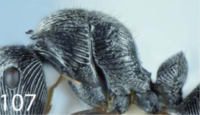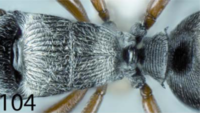Polyrhachis snellingi
| Polyrhachis snellingi | |
|---|---|

| |
| Scientific classification | |
| Kingdom: | Animalia |
| Phylum: | Arthropoda |
| Class: | Insecta |
| Order: | Hymenoptera |
| Family: | Formicidae |
| Subfamily: | Formicinae |
| Tribe: | Camponotini |
| Genus: | Polyrhachis |
| Subgenus: | Aulacomyrma |
| Species: | P. snellingi |
| Binomial name | |
| Polyrhachis snellingi Kohout, 2007 | |
Known only from the holotype. The specimen was collected in a malaise trap sample from secondary lowland rainforest.
Identification
Kohout (2007) - P. snellingi is a very distinctive species. It is the only known member of the subgenus having the lateral striation of the first gastral segment extending transversely across its anterior face.
Keys including this Species
Distribution
Distribution based on Regional Taxon Lists
Indo-Australian Region: New Guinea (type locality).
Distribution based on AntMaps
Distribution based on AntWeb specimens
Check data from AntWeb
Countries Occupied
| Number of countries occupied by this species based on AntWiki Regional Taxon Lists. In general, fewer countries occupied indicates a narrower range, while more countries indicates a more widespread species. |

|
Estimated Abundance
| Relative abundance based on number of AntMaps records per species (this species within the purple bar). Fewer records (to the left) indicates a less abundant/encountered species while more records (to the right) indicates more abundant/encountered species. |

|
Biology
|
Castes
Known only from the worker caste.
Nomenclature
The following information is derived from Barry Bolton's Online Catalogue of the Ants of the World.
- snellingi. Polyrhachis (Aulacomyrma) snellingi Kohout, 2007a: 237, figs. 101, 104, 107 (w.) NEW GUINEA.
Unless otherwise noted the text for the remainder of this section is reported from the publication that includes the original description.
Description
Worker
Holotype: TL c. 4.59; HL 1.15; HW 1.06; CI 92; SL 1.28; SI 121; PW 1.00; MTL 1.15.
Anterior clypeal margin with shallow notch medially; in profile clypeus virtually straight with only very weakly impressed basal margin. Frontal carinae sinuate with laminate lobes. Sides of head weakly convex, gently converging anteriorly, curving behind eyes into relatively shallow preoccipital margin. Eyes convex, in full face view clearly breaking lateral cephalic outline. Mesosomal dorsum only partially marginate. Pronotal humeri armed with very strong, anteriorly directed, broad-based spines, with raised margins, central areas distinctly concave; lateral margins of spines extended posteriorly for some distance, merging with outermost dorsal striae and curving onto sides, not reaching distinct promesonotal suture. Mesonotal dorsum marginate; propodeum poorly margined, outermost striae delimiting lateral edges of dorsum and terminating in downward and weakly inward curved angles. Propodeal dorsum descending into declivity in even, uninterrupted curve. Petiole with both faces convex, dorsal margin acute; lateral spines relatively short, acute, curved weakly backwards and upwards. First gastral segment with anterior face concave; dorsal margin of concavity sharp, not elevated above dorsal face of segment.
Mandibles finely, mostly longitudinally, striate. Head, including clypeus, distinctly striate; striae mostly longitudinal on front of head and vertex, somewhat oblique on sides. Dorsum of mesosoma distinctly longitudinally striate, striae converging anteriorly; dorsal surfaces of pronotal spines not striate, finely shagreened. Mesonotal-propodeal dorsum longitudinally striate, striae converging posteriorly towards declivity. Petiole with anterior face transversely striate; posterior face with fan-shaped striae running from apex of dorsal margin towards sides and base of segment. Anterior face of first gastral segment with transverse striae that are continued posteriorly along sides and towards dorsum; dorsal surface more finely, longitudinally, striate.
Numerous erect or semierect, yellowish or off-white hairs, shorter than greatest diameter of eye, present on most body surfaces. Mostly greyish or silvery, appressed or semierect pubescence present in various densities on most body surfaces, sparse on head, rather abundant on pronotal dorsum and mostly confined to interspaces between striae and pronotal spines. Propodeal dorsum with pubescence relatively long and distincly curved towards midline. Gastral dorsum with rather dense pubescence partly obscuring sculpture.
Black, mandibular masticatory border very narrowly and funiculi towards apices, very dark reddish-brown. Legs generally medium reddish-brown, apices of mid and hind femora, tibiae and first tarsal segments, very dark reddish-brown.
Type Material
HOLOTYPE: INDONESIA, IRIAN JAYA, PT. Freeport Concession, Siewa camp, 03.04ºS, 136.38ºE, 200ft, 18-30.iv.1998, lowland secondary rf., Malaise trap, R. R. Snelling #16 (worker). Type distribution: unique holotype in Los Angeles County Museum of Natural History.
Etymology
Named in honor of its collector, Roy R. Snelling of the Natural History Museum of Los Angeles County.
References
References based on Global Ant Biodiversity Informatics
- Janda M., G. D. Alpert, M. L. Borowiec, E. P. Economo, P. Klimes, E. Sarnat, and S. O. Shattuck. 2011. Cheklist of ants described and recorded from New Guinea and associated islands. Available on http://www.newguineants.org/. Accessed on 24th Feb. 2011.
- Kohout R.J. 2007. Revision of the subgenus Aulacomyrma Emery of the genus Polyrhachis F. Smith, with descriptions of new species (pp. 186-253). In Snelling, R.R., Fisher, B.L. & Ward, P.S. (eds). Advances in ant systematics: homage to E.O. Wilson 50 years of contributions. Memoirs of the American Entomological Institute 80: 690 pp.

